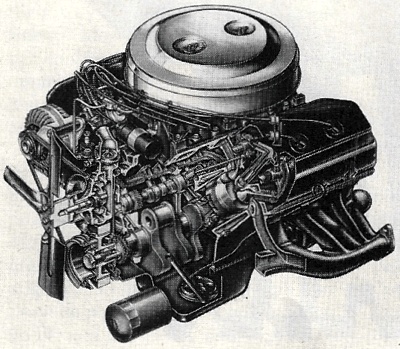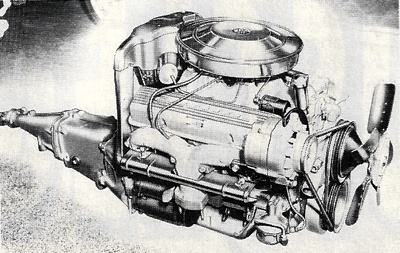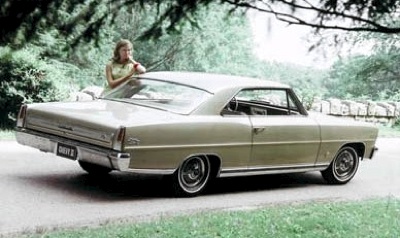|
American Muscle Cars of 1966
|
Country: |
 |
|
If you lived in Southern California in
1966 and you loved automobiles, you were in the right place at the right time. With so many fantastic new muscle machines to choose from, the cruising scene became a sort of rolling
automobile commercial. Baby boomers were entering the job market in droves (unemployment figures were the lowest for the USA in 13 years), allowing the purchase of the vehicles they'd dreamed about since puberty. Others were off to college or the war in Vietnam, putting car dreams on hold, some forever.
The government was turning its attention toward the
automobile, in the interest of safety and the environment. Ralph Nader's attack on the Corvair prompted GM to "investigate" his private life. They offered a public apology in February. There was an abundance of cruising locales all across America, but none quite as famous as Van Nuys Boulevard in Los Angeles' San Fernando Valley, Colorado Boulevard in nearby Pasadena and Woodward Avenue in Detroit. La La Land offered the big advantage in terms of weather - you could cruise year-round with little danger of rainfall.
Life was not always a bowl of cherries in Los Angeles or Detroit. Race riots clouded life in both cities, and the trend spread nationwide over the next few years. But it was truly cruising's heyday. Kids weren't into drugs as a daily ritual, the young American's rite of passage was geared toward the
automobile, and there were more young people with money to spend than ever before.
And what a car year it was! Up and down the Boulevard, this was truly a time of change. The success of the GTO in 1964 more or less assured that copies would follow, and follow they did! Chevrolet dealers were displaying the new mid-size Chevelle, which grew a bit and could be had as an SS 396 with a single quad and twin Supercharger as an option, rated at 325 hp - or as a 360-hp version with more toys under the hood. The smaller brother Chevy II was a junior supercar, with the optional L79, 350-horse 327 small-block. This rocket was complete with big valve fuel heads, 11:1 compression and forged pistons. Combined with a special hi-riser manifold, 585 cfm
Holley carb, hydraulic cam and the sweet Muncie 4-speed, 0-to-60 times were in the 7s, while the quarter came up in the 14s when driven right. It could also be argued that it was one of the best-looking Bowtie bombers ever. This is the package that Bill Jenkins used to tangle with the Street
Hemi power-plants in A/Stock competition. "Grumpy's Toy" was a crowd favourite then.
While the Corvette was a sports car and wasn't considered a musclecar in the pure sense, the new 427 solid-lifter "porcupine"
engine rated at 42 5 hp made the two-seater the hottest thing on the street that year. In fact, I owned a new 425-horse coupe hack then and recorded a 12.66 ET at 108 mph at Lions Drag Strip in Southern California, on stock 6-inch tires with the hubcaps yanked off, bone stock. The '67 Tri-Power job couldn't stay with the '66 425-hp model (originally rated at 450 hp), though the '67 owners hated to admit it. With the exception of a 427 Cobra, the'66 425-horse 427 Vette was king. Even the Hemis stayed clear. That nasty 427 was also available in Chevy's full-size models, and a Biscayne coupe optioned with this
engine could be a real sleeper. They wreaked havoc in NHRA B/Stock racing that year.
Dodge/Plymouth Street Hemis
In 1966 the Dodge/Plymouth Street Hemis were the big deal. They came about as a result of NASCAR rules that required all basic "stock" race engines to be available to the public in assembly line street models, with production of at least 500 units a year. Chrysler's marine
engine plant built the units, with a total of 4000 such cars produced between '66 and '71. Early Street
Hemi engines used the regular race heads, but with s ofter valve springs and 10.5:1 compression. Dual Carter 4-barrels, forged pistons, a beefed-up bottom end and solid-lifter cam made it as close as you could come to a full race
engine for the street. Rated at 425 hp, true dyno output was closer to 480 hp at 6000 rpm. Like many of the era's musclecars, street performance depended heavily on tires and gearing.

Chrysler's Street Hemi was awesome, and remained the dominant performance engine for many years.
 Chevrolet's famous 350 hp 327 Corvette L79 engine, introduced in the Chevy II in 1966.
Chevrolet's famous 350 hp 327 Corvette L79 engine, introduced in the Chevy II in 1966.
 1966 Chevy II Nova SS.
1966 Chevy II Nova SS.
|
A well-tuned Street
Hemi on cheater slicks with 4.11 or 4.56 gears could run 0-to-60 in the 5-second bracket and quarters in the mid-13s at 105 mph. They weren't the greatest when it came to driving in stop and go traffic, but for a little over $4000 you had a true street killer, a real pedal throbber. The 440-cubic-inch Wedge
engine grew out of the 426, as did a new model, the Charger. TV commercials of the day proclaimed, "We bought a Charger, 'cause it's larger!" The odd-looking Dodge featured a fold-down rear seat, hidden headlamps and fast-back roofline. And it could be had with the Hemi.
Flint, Michigan's honour was being weakly defended by the Buick GS, still hampered by the old Nail Valve V8, and a year away from a "modern" design. They're quite collectible today. Oldsmobile's 4-4-2 package had a name for itself in '66. The 400-cubic-inch 4-barrel version had a 350-hp rating. With the new three-deuce arrangement, it was up to 360 hp at 5000 rpm. These cars ran in the low 14s when driven well. This tri-carb system is noteworthy because it used a progressive mechanical throttle linkage, rather than the erratic vacuum system used on the GTO. This gave more consistent starts and shifts with the 4-speed. Also there was a neat, less-known feature: A little bolt-on plug on the left side of the intake manifold could be removed and turned over to block off
exhaust heat from the carburettors in warm weather. This could add as much as 10 to 15 hp. Olds offered dealer-installed "Force Air" kits for the tri-carb engines. Known as the W-30 option, the carbs were fed by 4-inch flexible rubber tubes from behind the grille, plus a wild 308-degree camshaft and special valve springs were used. Anybody serious about the Olds used these kits.
Ford's news on the street was the Fairlane and Mercury Cyclone GTs (the Cyclone was selected as the Pace Car for the Indy 500 race). This was an all-new design that looked like a sales winner on paper but fell way behind the competition. The GT's motivating force was the 390-cubic-inch version of the popular FE
engine, but with a special high-lift cam,
Holley carb and dual
exhaust. This GT was underrated at 335 hp at 5200 rpm (common practice in the '60s, to get the cars into a lower drag strip class—in this case, C Stock). Unfortunately, the 390 GT
engine wasn't all that strong. It would run with the milder cars, like the Buick GS and SS 396 Chevelle, but was no competition for the likes of a Ram Air GTO or a 409 Chevy.
Those who wished for more power could opt for the 427 motor. There was even a lightweight race package' that had a production run of approximately 5 7 units. Included in the package was a full-tilt medium-riser 427, complete with Holleys and a totally revised induction system. Other notable features of the package included a pin-on fiberglass hood, modified shock towers and total absence of undercoating and sound deadeners. Shelby's GT 350 was pure small-block muscle and could be had with a Paxton Supercharger as an option in '66, though this was a real rarity. In fact, with just 2375 GT 350s produced, it wasn't often that you would find yourself alongside one at a light.
These hi-po 289s could run with some of the hotter street machines, no problem. Pontiac came close to selling 100,000 GTOs as the sales year was tallied in December, the month that Walt Disney died. The Ram Air option was still dealer-installed, but a new cam and valve springs improved performance over the '65 models. These were low 14-second cars when everything was right. More news came from Pontiac in the way of its new Sprint Six. Wanting to do something for the low end of the "fun car" market, the company came up with an overhead cam version of the 230-cubic-inch inline six. A special
cylinder head bolted to the standard block, with an enclosed tooth belt system to drive the cam, operated inclined
valves through short rocker arms.
The high performance version of this mill had 1'0.5:1 compression, 4-barrel carburettor on a ram-type manifold, hot camshaft, low-restriction air cleaner and split
exhaust manifolds feeding into one large tailpipe and muffler. It was rated at 207 hp with redline at 6500 rpm. With a 4-speed, it was one of the really fun cars of the mid-'60s. More and more of us were climbing aboard Boeing 707s and flying to places we'd never been, but an airline strike in July shut down 60 percent of domestic service. Crime was up 465 percent from levels in 1961, according to J. Edgar Hoover of the FBI. The world also heard about the third heart transplant operation, which took place in Houston. Lap belts were standard equipment in the front seats of automobiles, but with actual use down around 3 percent and weak drunk driving laws, 48,500 people managed to die in traffic accidents. But the sounds of big-inch motors were the tunes the Americans enjoyed on the boulevards in 1966.



